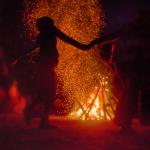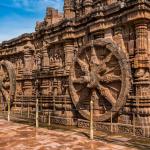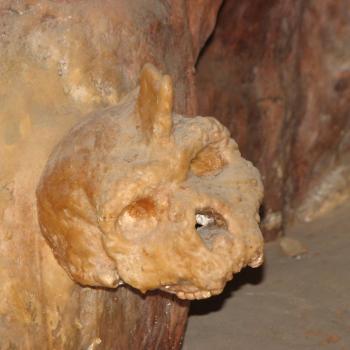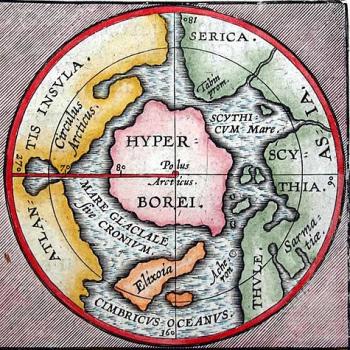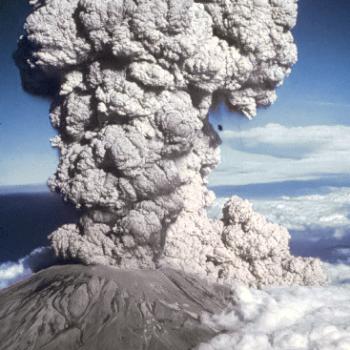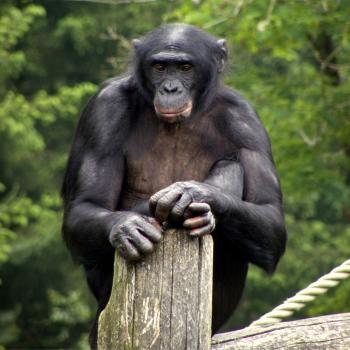Long before the advent of Judaism, Christianity and Islam, reincarnation was a near-universal belief that was almost certainly linked to a sacred calendar. Cross-cultural evidence suggests a multi-phased process that began in spring when early farming cultures set aside a special day (or week) for people to get drunk, sing, dance and have sex. The officially sanctioned orgiastic sprees were intended to invoke the universal power of fertility during planting season.
- Sumerian kings had intercourse with a priestess in a chamber at the summit of the ziggurat in the center of the capital city, re-enacting the union of the god and goddess of agriculture, Dumuzi and Inanna.
- The ancient Egyptians set aside a day each spring when drunkenness and sex was encouraged as part of a re-enactment of creation, when the gods re-populated the world after a flood.
- A springtime procession in ancient Rome was led by a giant wooden phallus to honor the god of fertility. The festival ended in public intercourse between a high priest and a noblewoman.
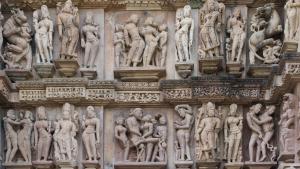
Winter solstice babies
On the winter solstice – nine months after the spring equinox – there would have been numerous pregnant women at or near full term in the crowds that gathered at stone temples aligned to the rising sun. Everyone expected that infants born on the solstice would be blessed by the extraordinary power of the reborn sun and could grow up to be heroes or kings. Every healer and diviner in the region would be in attendance.
For migratory hunter-gatherers and early farming cultures it was a common-sense adaptation for women to give birth in midwinter, a time when others were free to help. By spring the infants would be mature enough to manage and women could conceive again. During the week-long winter solstice ceremonies, births may have taken place in caves or the central chamber of a megalithic mound where sauna-like conditions would imitate the womb. The acoustics of drumming inside caves or closed chambers would certainly have helped induce labor. Cross-cultural myths from Greece to Korea describe divine beings being born in caves.
Mithra, Net, Caesar and Jesus
Numerous divine beings were said to be born in caves and/or on the winter solstice.
- Dating back to Indo-Iranian mythology and spreading to Europe, the pagan god Mithra was said to be born in a cave on the winter solstice. The Koguryo of North Korea describe a river goddess shut away in a dark room until the rays of the sun on the winter solstice caused her to conceive and give birth to an egg that hatched the first Koguryo king.
- The Greek author Plutarch wrote that the Egyptian Milky Way goddess Net could only give birth on the last five days of the year. Murals of Net show her body covered with stars and bent over in the shape of an arch, her legs representing the two southern “legs” of the Milky Way, which ‘stand’ on the southeast horizon in midwinter. In other words, Net symbolically gave birth where the sun rises in midwinter, effectively giving birth to the sun. Plutarch reported that just after the winter solstice Net gave birth to Osiris, Isis, Nephthys, Seth and Horus the Falcon, liaison to the sun god Re.
- The first Roman emperor Caesar re-branded himself by taking on the name Augustus in 27 BCE while officially associating himself with the sign of Capricorn and the miraculous regenerative power of the winter solstice. Although Caesar was a Libra, he made new coins with himself on one side and the December sign of Capricorn on the other, symbolizing the rebirth of Rome under his watch.
- In 336 CE, the Roman calendar would shift allegiances, identifying Jesus’ birthday as December 25.
The popular knowledge that heroes, kings and gods were born around the winter solstice likely motivated couples to enthusiastically participate in officially sanctioned sexual intercourse during the ealy spring planting season.
The ritual of reincarnation
Thousands of years ago, those who gathered for the winter solstice acted out a supernatural story of death and rebirth against the backdrop of megalithic temples that were exclusively located on the winter grounds of migratory birds. A range of evidence across numerous cultures suggests the bare bones of this dramatic metaphysical plot went something like this …
A communal funeral to release the souls of the year’s dead was held in late October so the souls could be carried away by birds taking off on their fall migration. Their destination was a sacred wintering ground where the birds delivered the souls to incubate in temples with egg-like design features, not unlike a divine nest.
The climax occurred at dawn on the winter solstice when the first rays of the reborn sun lit up processional routes of standing stones, traveled down dark passages into the inner sanctums of megalithic mounds and refracted into rainbow colors by slabs of quartz.
This was the moment everyone was waiting for, when the first golden beams of the sun’s rebirth quickened the dormant, incubating souls of the dead to reincarnation and new life. When the sun was reborn, so were human souls.
The sacred calendar came full circle as the reincarnated souls took up residence in the newborn infants that were present, or in the bellies of women about to give birth. The moment of dawn may have been celebrated by releasing birds from inner sanctums so diviners would chart their flight and predict the future heroics of the reincarnated souls.
Ancient megalithic sites around the globe share the major elements of the bird-enabled reincarnation process: Prominent egg-shaped stone forms located on the winter grounds of migratory birds with a direct alignment to sunrise on the winter solstice, all constructed when reincarnation was a near-universal belief.
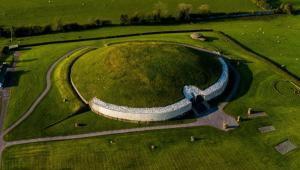
Masters of rebirth at Brú na Bóinne
When whooper swans left Iceland in late fall to cross the North Atlantic, the ancient Icelanders believed the swans carried souls with them.
The whooper flocks migrated to England and Ireland, with one large group spending the winter along the River Boyne in County Meath. The whoopers established their wintering ground countless millennia before three megalithic mounds were built inside a sharp bend in the river more than 5,000 years ago. The whoopers still return today, though far fewer in number.
The mound known in Gaelic as Brú na Bóinne was originally ovate, measuring 354 feet on the long axis by 298 feet on the short axis, according to archaeologist Aubrey Burl. It was designed so the dawning winter solstice sun would shine down a 60-foot passage and into a central chamber with a corbeled domed ceiling about 20 feet high. Thousands of smooth, egg-shaped ‘river-rolled’ quartz stones were imported several miles to the site as fill for the mound, like a nest of eggs.
The Celts didn’t build the mounds but they adopted them into their mythological world with whooper swans symbolizing the soul. Brú na Bóinne was the home of the Tuatha Dé Danann (Tribe of Danu), who were known as “masters of rebirth” in the Irish countryside into the early 20th century. Mastering the discipline of rebirth meant being able to choose what family the soul would be born into next, similar to the practice described in The Tibetan Book of the Dead.
Among the distinguished members of the Danann tribe was Tuan MacCarell, who survived Noah’s flood by reincarnating as a salmon and lived dozens more lifetimes, ultimately relating the history of Ireland to St. Patrick.
Ancient Irish heroes
The trio of Irish cultural heroes are Lugh, Cuchulain and Finn MaCool, all associated with Brú na Bóinne. Each was a master of every skill, presumably learned from living many lives. Cuchulain was miraculously conceived at Brú na Bóinne by the time-traveling Lugh and the human Dechtine. Finn was mentored by the River Boyne, where heavenly hazelnuts of wisdom dropped into the flowing waters.
When the Tuatha Dé Danann were ultimately defeated by the invading Milesians from Spain, they agreed to surrender and disappear into the spirit world under the mounds and the waters. But an Irish legend recounted in the book, The Fairy Faith in Celtic Countries (1911, Oxford University Press), suggests the Danann became spirits only to reincarnate themselves in the bellies of the Milesian princesses, a neat metaphysical trick that would have returned them to power.
The legend could also be interpreted as an expression of the cultural survival of the musical and poetic Dananns. The book was authored by W.Y. Evans-Wentz, a college classmate and longtime friend of the poet W. B. Yeats. In 1957, Evans-Wentz would be the first to translate The Tibetan Book of the Dead.
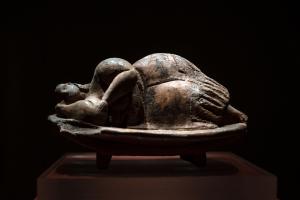
The Hypogeum of Malta
On the island of Malta, a popular destination for migratory birds on the Mediterranean/Black Sea Flyway, a three-level underground tomb known as the Ħal Saflieni Hypogeum was built about 6,000 years ago, and was the final resting place for 7,000 people buried over a period of 1,200 years. A voice speaking at about 110 hertz into a small oval niche in the Oracle Room produces an eerie echo that radiates throughout the tomb complex.
At dawn on the winter solstice, the Hypogeum’s design allowed sunlight to penetrate down to the second level and into the Holy of Holies. Also on the second level is a sculpted mother goddess known as the Sleeping Lady, whose body is made up of egg shapes, including her legs, arms, and head. There are more than a dozen large chambers in the complex, most of which are oval shaped.
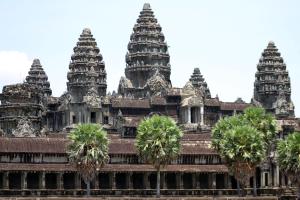
The ovoid towers of Angkor Wat
Tonle Sap Lake in Cambodia is one of the largest wintering grounds for migratory birds in Southeast Asia. Just a few miles away, the ovoid conical towers at Angkor Wat represent the mythical Mount Meru, where Hindu souls are reincarnated.
On the walls of the temple is the mythical Garuda bird, who discusses the metaphysics of reincarnation in the Garuda Purana. A small temple on a nearby hill was the designated viewpoint for watching the winter solstice sun rise over the towers. Numerous other examples of metaphysical reincarnation at sacred sites are included in my upcoming book, referenced below.
If indeed the process of reincarnation was indeed celebrated at megalithic temples on the winter solstice, it was a compelling and elegant conception that incorporated the entire community in the perpetual cycle of life.
The promise of spring
Why didn’t our ancestors choose a date in early spring for New Year’s Day? Shoots and tendrils are poking out, animals of every kind are awakening, and migratory birds are arriving.
The weeklong winter solstice celebration may have evolved by natural selection as a method to maintain the physical, psychological, emotional, and spiritual health of the community. As winter cold sets in and the days grow short, people can suffer from psychological problems linked to inactivity and/or a lack of sunlight. Internal conflicts may arise when snowy weather confines the group to a limited area.
A midwinter mandate that people get outside and travel to the nearest megalith to spend a week singing, dancing, celebrating the birth of children, and reinforcing their shared beliefs about the universe may have been just what the doctor ordered. The winter solstice was a chance to physically move around, to see relatives and old friends, to consult one of the many healers in attendance, to eat and drink more than usual, to celebrate the deeds of ancient ancestors, and to welcome the birth of new heroes. Our distant ancestors latched onto the only tangible sign that winter would come to an end and turned it into the biggest festival of the year.
(The last in this three-part series will be published on Thursday, Dec. 22. Ben H. Gagnon is an award-winning journalist and author of Church of Birds: An Eco-History of Myth and Religion, scheduled for release in March 2023 by John Hunt Publishing, and now available for pre-order. More information can be found at churchofbirds.godaddysites.com.)

